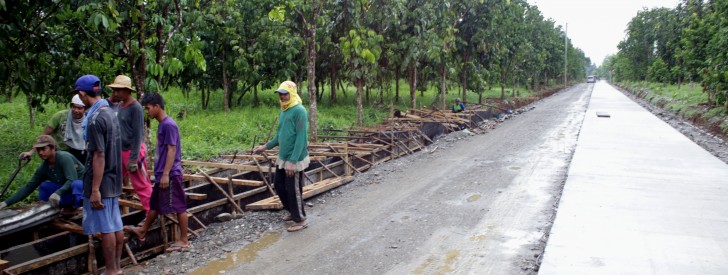 One of the Farm-to-Market Road projects of the Department of Agriculture's Philippine Rural Development Project (DA-PRDP) Bagong Silang-Macatoc FMR in Oriental Mindoro is being constructed to support the calamansi farmers in the province. The P20.6 million concrete road measures 2.79-kilometer.
One of the Farm-to-Market Road projects of the Department of Agriculture's Philippine Rural Development Project (DA-PRDP) Bagong Silang-Macatoc FMR in Oriental Mindoro is being constructed to support the calamansi farmers in the province. The P20.6 million concrete road measures 2.79-kilometer. No more gravel farm-to-market roads—DA
The government, under the Aquino administration, no longer builds “all-weather” gravel farm-to-market roads (FMRs) as it resolved as early as July 2010 to build only concrete FMRs in the country, according to the Department of Agriculture (DA).
Agriculture Secretary Proceso Alcala said that the primary problem with these gravel roads is that they are not resistant to the effects of changing climate.
“Many of these roads are damaged—or disappear—after a flood or typhoon. The Department of Agriculture would then receive new requests to rebuild the same roads. The result was huge amounts being spent on roads that are repaired or rebuilt over and over,” Alcala said.
The Secretary added that construction and repair of gravel roads involve other issues such as favored contractors and duplication of projects. These have pushed the DA to advocate for the construction of concrete FMRs only.
Costs vs. benefits
Secretary Alcala recalled that at first, partner financing agencies objected on the idea of “concrete FMRs only,” citing the high cost of constructing such.
“We explained that the ₱10 million standard cost of a kilometer of six-inch-thick, five-meter-wide concrete FMRs, following DPWH [Department of Public Works and Highways] standards, would be cheaper than constructing and reconstructing gravel roads, particularly with worsening floods,” Secretary Alcala said.
The DA has mainstreamed climate change adaptation in all its projects and this entails building climate-resilient infrastructure such as FMRs and bridges.
“We believe that the benefits of building concrete FMRs instead of repairing gravel roads every now and then outweighs its costs in the long run, particularly in the context of climate change adaptation,” Alcala said.
2,440 kilometers worth ₱24.7 billion FMRs soon
As the DA pushes for climate-resilient agricultural infrastructure, it has teamed up with 49 provincial and local government units (LGUs) to build a total of 2,440 kilometers of concrete, climate-resilient FMRs worth ₱24.7 billion under the World Bank-assisted Philippine Rural Development Project (PRDP).
Under the PRDP, LGUs as project proponents will have to share at least 10% equity. The World Bank will finance 80% of the project and the remaining expenses will be covered by the DA.
Municipal Mayor Diosdado Pallasigue of Isulan, Sultan Kudarat, one of the LGU partners of a PRDP sub-project said that the P36.7 million-worth FMRs they have availed of under the PRDP will spur agricultural growth in their province as these roads serve about 2,000 hectares of farmlands and 1,000 households.
Cesar Falle, Barangay Captain of Kudanding village in Isulan, said that since the 1970s, these roads have been almost impassable and farmers have always had a hard time bringing their products to the market especially during rainy seasons.
Because of poor accessibility, Falle recalled that they used to spend ₱40.00 for every sack of rice to be hauled to the market.
“But now, the roads have been improved and transporting our products has become easier and cheaper; hence, the incomes of farmers have increased,” Falle shared.
The PRDP FMR projects are expected to connect about one million farmers and their farms and enterprises to highways and markets—decreasing production costs, increasing yields and improving farmers’ incomes. All these projects were approved based on careful and extensive feasibility studies, including value chain analyses.
Transparency and accountability in FMR projects
“Not only we do ensure that FMRs really link farmers to the market and connect agricultural value chains. We also guarantee that these projects meet prescribed standards of the World Bank and the DPWH and conditions set with the contractors,” Secretary Alcala said.
Alcala stressed that gone were the days when FMRs are built for political patronage, when roads are built based on who the proponents are.
To avoid duplications and ensure that FMRs serve their intended purposes, the DA uses an innovative Google Earth-based geotagging tool. This allows computer-based checking of road proposals, as well as monitoring from construction until completion.
Developed by the DA under the Mindanao Rural Development Program (MRDP), the tool has been adopted by other agencies not only for roads but also for other infrastructure projects.
The DA likewise received the NEDA Good Practice Award in 2012 for this innovation, which has also been recognized by the World Bank as a Global Best Practice recommended for replication in other countries.
“Dahil sa tuwid na daan, magkakaroon na tayo ng mas matibay na mga daan,” Secretary Alcala said.
“Tuwid na daan” (straight path) is the Aquino administration’s catchphrase for its good governance agenda. (Jan P. Dacumos, DA-AFID)
